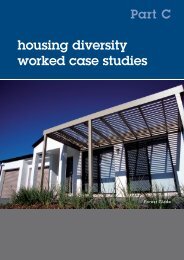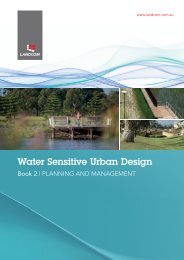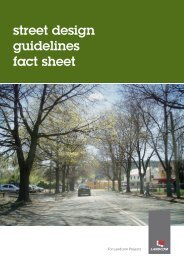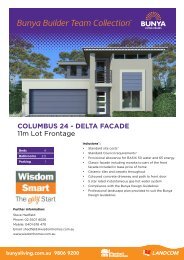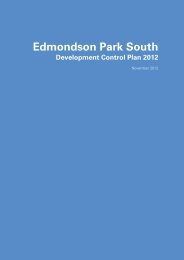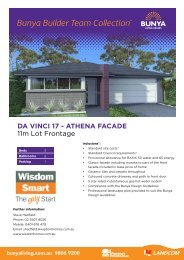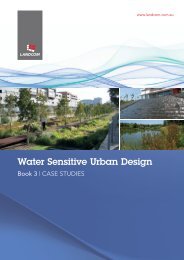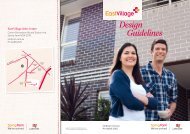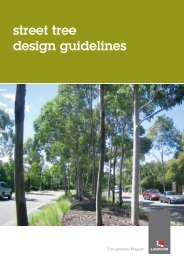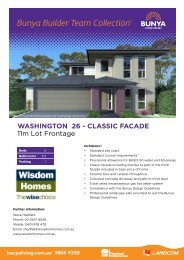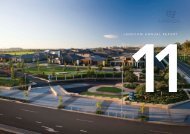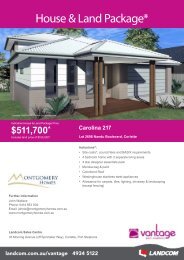SUSTAINABILITY REPORT - Landcom
SUSTAINABILITY REPORT - Landcom
SUSTAINABILITY REPORT - Landcom
Create successful ePaper yourself
Turn your PDF publications into a flip-book with our unique Google optimized e-Paper software.
GLOSSARY<br />
AVERAGE RECURRENCE INTERVAL (ARI)<br />
The long-term average number of years<br />
between the occurrence of a flood as<br />
big as (or larger than) the selected<br />
event. For example, floods with a<br />
discharge as great as (or greater than)<br />
the 20-year ARI flood will occur on<br />
average once every 20 years.<br />
BASIX<br />
The Building Sustainability Index is a<br />
web-based planning tool designed to<br />
assess the potential performance of<br />
new homes against a range of<br />
sustainability indices: landscape,<br />
stormwater, water, thermal comfort<br />
and energy.<br />
CARBON DIOXIDE (CO 2 )<br />
Carbon dioxide is the most significant<br />
greenhouse gas, not because it is the<br />
strongest but because it is released in<br />
such vast quantities, mainly as a result<br />
of burning fossil fuels (coal, oil, and<br />
gas). Concentrations in the atmosphere<br />
have risen rapidly (by 30%) since the<br />
industrial revolution.<br />
CARBON DIOXIDE EQUIVALENT (CO 2 -E)<br />
Greenhouse gas emissions which<br />
include other gases (for example<br />
methane) are often measured in tonnes<br />
of carbon dioxide equivalent, which<br />
means the equivalent amount of<br />
CO 2 emissions which would have the<br />
same effect.<br />
DIPNR<br />
Department of Planning, Infrastructure<br />
and Natural Resources.<br />
GREENHOUSE GAS EMISSIONS<br />
Greenhouse gases absorb heat and<br />
warm the lower atmosphere, although<br />
they make up very little of it by volume<br />
(less than 1%). In the absence of<br />
greenhouse gases the average global<br />
temperature would be about -18 o C, and<br />
the earth would be uninhabitable.<br />
However, since industrialisation the<br />
concentration of greenhouse gases has<br />
been rising, mainly as a result of<br />
burning fossil fuels (coal, oil and gas).<br />
CO 2 levels, for example, have increased<br />
by 30%. This is causing the climate to<br />
change, and the global temperature to<br />
rise. The more common greenhouse<br />
gases are carbon dioxide (CO 2) and<br />
methane.<br />
GREYWATER<br />
Domestic wastewater excluding toilet<br />
waste but may include wastewater<br />
arising from a hand basin, kitchen,<br />
bath, shower and laundry.<br />
MACROPHYTE ZONE<br />
An area of plants such as rushes and<br />
reeds that improve water quality by<br />
trapping fine particles and nutrients<br />
such as nitrogen and phosphorus.<br />
MASTERPLAN<br />
An interpretation of the planning<br />
controls and urban design principles for<br />
a site setting the framework for future<br />
development.<br />
MODERATE INCOME HOUSING<br />
Housing that is affordable to those<br />
households on incomes between<br />
$45,000 and $68,000 per year (2003<br />
dollars).<br />
NatHERS<br />
The Nationwide House Energy Rating<br />
Scheme is a software application that<br />
simulates the energy consumption of a<br />
house design. Developed by the CSIRO<br />
in consultation with Australian<br />
governments, NatHERS provides a<br />
rating of between 0 and 5 stars to<br />
show the potential of a house to be<br />
energy efficient. The rating is based on<br />
a detailed computer simulation of the<br />
house using hourly weather data.<br />
A rating of 0 represents a poorly<br />
performing house, while a rating of<br />
5 is excellent.<br />
NPWS<br />
National Parks and Wildlife Service.<br />
OHS&R<br />
Occupational Health, Safety and<br />
Rehabilitation.<br />
POTABLE WATER<br />
Water that is drinkable.<br />
RIPARIAN CORRIDOR<br />
A riparian corridor is the land directly<br />
adjacent to or surrounding a natural or<br />
artificial waterway, including rivers,<br />
intermittent or permanent creeks and<br />
streams, wetlands and lakes. The<br />
corridors provide a crucial link between<br />
land and water ecosystems.<br />
RTA<br />
Roads and Traffic Authority.<br />
STAKEHOLDER<br />
Any individual or group that has a<br />
vested interest in the success of an<br />
organisation in delivering intended<br />
results and maintaining the viability of<br />
the organisation’s products and<br />
services. For example, the local<br />
community is a stakeholder in a major<br />
construction development.<br />
Stakeholders influence programs,<br />
products, and services.<br />
TERRESTRIAL<br />
Living or growing on land rather than<br />
in water or air.<br />
TRIPLE BOTTOM LINE (TBL)<br />
The concept of considering not just the<br />
economic value a corporation creates,<br />
but also how its activities impact<br />
society and the environment.<br />
WATER SENSITIVE URBAN DESIGN<br />
(WSUD)<br />
WSUD refers to the design principles<br />
that aim to reduce the impact of<br />
interactions between the urban built<br />
form (including urban landscapes) and<br />
the urban water cycle as defined by the<br />
three urban water streams of potable<br />
water, wastewater and stormwater.<br />
47



